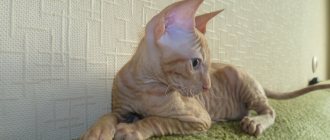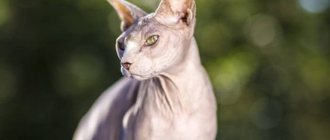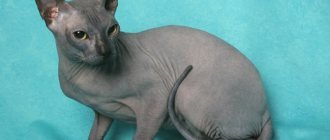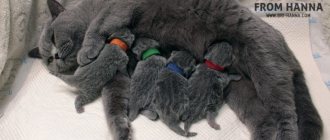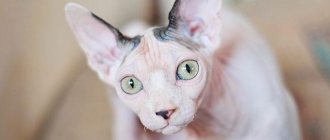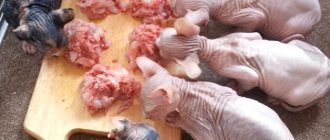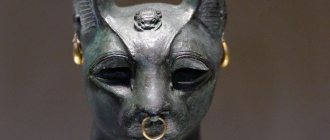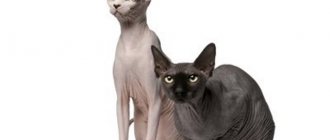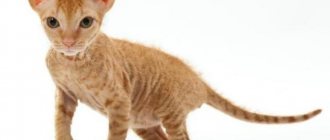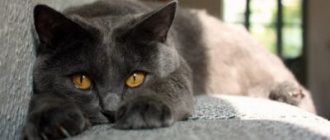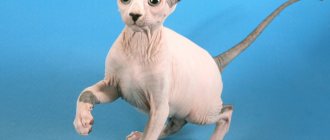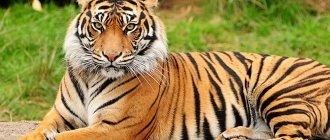Cats without hair are no longer considered a novelty, and it is no longer possible to surprise with them. Modern breeds of such cats make many people smile and want to touch their skin and stroke them. The Sphynx Brush is a cat with little fur on its body - the hair is short and sparse, more like fluff.
Don Sphynx brush.
Origin story
Brush during molting period.
The official ancestor of this breed is a cat that was rescued in 1987 from the hands of street hooligans. This was a respectable act done by professor of the Pedagogical Institute E. Kovalev. This animal does not have hair on certain parts of the body. Soon she became completely bald. Veterinarians and the cat's owner explained this by shock or the consequences of a previous illness. After some time, the cat gave birth to new kittens, which initially looked like their mother. These kittens were mistakenly recognized as sick and for this reason they were killed, except for one.
The origin of the Don Sphynx Brush began with this kitten. During the formation of the breed, Brushes were crossed with shorthaired breeds. Today the gene pool of the breed is fully formed and pure. In 1996 they received recognition from the World Cat Federation or WCF. They received their own standard of appearance and an accurate description of their appearance. Today this breed takes part in many international cat shows, competitions and other events in the world of felinology.
brief information
| Breed name | Don Sphinx Brush |
| Country of origin | Russia |
| Coat | hard, sparse, short, stubble-like hair |
| Height (height at withers) | 25-30 cm |
| Weight | cat – 3.5-5 kg, cat – 5-7 kg |
| Lifespan | 12-15 |
| Breed characteristics | inquisitive, friendly, active |
| Kitten price | 15-30 thousand rubles |
Description and standard
Among breeding specialists, these cats are usually called hairless, not hairless. All these breeds are characterized by a high degree of friendliness and good nature. There are also many rumors and myths associated with this breed about their hypoallergenicity. However, this is just a myth, since they cause allergies just like other types of cats.
What should a brash sphinx look like?
Since the hair of this breed is weak or completely absent, all body imperfections are noticeable at first glance at the animal. The Brush Sphinx must have:
- stocky, strong body of medium size;
- developed paws with strong muscles;
- straight line between back and tail;
- tail proportional to the body, tapering to a rounded end;
- the toes are long and gathered into a ball;
- the head is wedge-shaped;
- pronounced arches above the eyebrows;
- the muzzle is short with characteristic wrinkles on the forehead and pronounced whisker pads;
- the ears are large, the tips are rounded;
- almond shaped eyes.
The cat's body has a large number of wrinkles and a small amount of fur, more like fluff. A cat may have hair on its paws, back, and tail, but by the age of two it goes away completely. The amount of wool in sphinxes is a variable value that changes depending on the time of year.
Sphynx kitten brush.
Why does the Sphynx begin to grow hair?
Sometimes such cats suddenly begin to grow hair. However, there are several reasons for this phenomenon. With the arrival of autumn and winter, the cat begins to become covered with short, soft fluff. In some areas it may even be of sufficient length. This can happen even if it only gets cold outside the window, but the apartment is still warm. This is due to the influence of the biological calendar.
Another reason for this is hormonal changes. The fur may grow or, conversely, fall off. Changes occur during estrus, pregnancy, castration/sterilization, and disturbances in the functioning of internal organs. Hair may also fall out due to improper feeding, stress, change of place of residence and other reasons that may affect the animal.
Velours
Velor cats have longer and fuller coats than flocked cats. The Velor Sphynx is born with velvet hair that is clearly visible to the touch. The length of the villi can reach up to 3 mm. Velor Peterbalds have longer hair on their paws, face and tail than on other parts of the body.
With age, hair follicles die off. Velor Don Sphynxes completely lose their hair. In adulthood, these cats appear completely hairless. Adult Peterbalds may still have remnants of hair on their paws and head.
Character and special habits of brushes
These cats can be characterized as playful and inquisitive. Over time, they become full-fledged members of the family. They choose one master or favorite for themselves, they always obey him unquestioningly, carrying out all his commands. They treat other people with warmth and good nature. Also, the Sphynx Brush is intelligent, but tends to be touchy. However, he is not vindictive. You should not punish this animal physically and psychologically.
Brushes can be called empaths, capable of sensing changes in a person’s mood. They react to this, trying to pity and cheer up the person. Cats love affection, all kinds of manifestations of tenderness, care, and attention to themselves. This breed is characterized by quickly getting used to a new place, observing all the requirements that the owners place on them. If the animal refuses to visit the tray assigned to it, you just need to move it to another place.
Sphynx kittens.
Hygiene
Don Sphynxes have some features:
- The Donetsk people are sweating. Everything.
- Their skin secretes a protective brown lubricant called pectin. But it does not pollute the skin with proper care.
- Sphynx cats, like other cats, groom themselves. But there are places that are difficult or impossible for them to reach: the tummy, muzzle, neck, etc. They need especially careful care.
Based on all these features, Sphynx skin care is as follows:
- The Sphinx is bathed once a month; if the skin gets dirty faster, you can bathe it once every 2 weeks.
- Every day the skin of the sphinx is wiped with a natural cloth (linen, cotton) soaked in a special caring lotion or warm water.
- For bathing, use natural soft shampoo and a gentle sponge. One of the 3 baths is done with a cleansing antibacterial shampoo for Sphynxes.
- In winter, Donchak needs insulation (clothing), and in summer - protection from the sun (for example, special cream or light clothing).
Photo gallery: which shampoos are suitable for the Don Sphynx
Ms. Kiss “Graceful Sphinx” is suitable for all hairless cats
Elite for hairless breeds gently cares for the skin of the Sphynx
Doctor Vic shampoo for hairless breeds Royal Groom Care and Moisturizing is suitable for all hairless animals
Care for claws, teeth, eyes, ears
Comprehensive care for the Don Sphynx is as follows:
- Ear care. To do this, you will need cat ear cleaning lotion, cotton swabs, and cat ear cleaning drops.
- Clean your ears once every 5 days. Drops are placed inside for cleaning, and the base of the ear is massaged for a minute or two.
- Then the auricle is wiped with a swab dipped in lotion.
- You will need: a piece of natural fabric and lotion to clean the eyes.
- To care for your teeth you will need a silicone toothbrush (if your cat has weak gums, it is better to take a piece of natural fabric) and cat toothpaste.
- You will need a nail clipper.
Sphynx brush colors
Brush Sphynx cats can have a wide variety of colors, among which the following types of colors are distinguished. There is a specially developed table of brush color codes in which you can see the identity of your kitten.
Sphynx color coding table.
Material on the topic: popular colors of the Scottish cat breed.
Plain
This type is also called solid color or solid color. With this type, the cat has a uniform color over its entire surface.
- White. This color is found in all cat breeds.
- Black. It can range from a deep rich color to gray, depending on the thickness of the coat.
- Blue. This color is a variation of the black color, but can be confused with it. To accurately determine the exact color of the animal, it is determined by the color on the stomach, eye rims, lips and testicles.
- Red. This color always has a tabby pattern. Sometimes this color can be confused with cream.
- Cream. A variety of red color.
- Pink sphinx.
Rare colors
These colors include various tortoiseshell colors, which are most often found in cats. There are different varieties of this color:
Sphinx Brush at three years old.
Black turtle - combination of red and black;- Blue - a combination of cream and blue colors;
- Turtle cinnamon;
- Turtle cream;
- Turtle Lavender.
There are other colors of Sphynx brushes that are also common among these cats:
- Chocolate. This is one of the black color options. This color is considered rare and does not occur often in this breed.
- Lilac. A type of chocolate color, but in light shades. Also applies to rare colors.
- Particolors. This can be bicolor and calico and the so-called calico chintz. It is a combination of tortoiseshell color combined with white.
- Color point.
- Tabby. There are several varieties of this pattern - marble or classic, tiger.
Rarer and more expensive tabby colors, which are especially valued among breeders, are:
- brown tabby;
- silver tabby;
- blue tabby;
- red tabby;
- cream tabby;
- chocolate tabby;
- cinnamon tabby;
- lavender tabby;
- fawn tabby.
The type of color does not affect the length of the animal's coat; the average hair length does not exceed 5 mm. and may vary depending on the molting period and other influencing factors.
Brush sphinx.
Hooded (rubber)
At birth, this type has no hair at all, and may also lack whiskers (whiskers, eyebrows and tactile hairs on the limbs). These kittens are often born with their eyes open, like human children. The color is further determined by the paw pads. The skin of naked kittens is thin, elastic, forming folds throughout the body. During the cold period, the entire body can become overgrown with sparse, fine hair.
Health and disease of the Brush Sphynx
Once every three months, the cat needs to be prevented from worms, and revaccinated once a year, according to the recommendations of veterinarians. One of the most common problems these animals face is diseases associated with the skin - dermatitis, irritation, rashes, etc. Congenital pathologies are rare in this breed, but they can acquire diseases that are more characteristic of them.
- Microphthalmos. A congenital pathology of the eyelids, in which the eyeball is smaller or underdeveloped, which can cause poor vision or complete blindness. The reasons for this have not been fully identified and are only being studied. With this pathology, veterinarians simply remove the damaged eye and, if possible, perform plastic surgery.
- Short lower jaw. Most often, this pathology occurs among Donetsk residents. In this case, an incorrect bite occurs, the jaws come into contact with each other and do not completely align.
- Turning of the eyelids. Characterized by weakening of the muscles of the eyelid ligaments. Solvable surgically.
- Dermatitis. Type of skin disease.
- Nipple hyperplasia. It is often transmitted genetically through the female line. The risk group includes females with light blue tones.
- Trichophytosis. The type of fungal disease is similar to lichen.
The breed is distinguished by its strong health. If you follow proper care, a balanced diet, contact veterinarians on time and get all the necessary vaccinations, your pet will be a joy for a long time. They rarely get sick, thereby causing their owners trouble and expense.
Material on the topic: all about the character and habits of Maine Coons.
Feeding
A velor kitten up to 3 months old should eat 5 times a day
Velor Sphynxes have an accelerated metabolism. To maintain the required body temperature, they consume more food than purrs of other breeds. Premium or holistic food is suitable for them. They contain quality ingredients and healthy vitamins. Such products include:
- Orijen Cat & Kitten;
- Purina Pro Plan;
- Royal Canin Sphynx Adult.
If you decide that your pet will eat natural food, try to maintain a balance between serving size and quality. Sphynxes can be given: lean fresh meat, boiled vegetables, cereals, eggs and sea fish. Do not feed cats: river fish, pork, bones, sweets. Representatives of this breed do not chew food well, so there should not be large pieces in his bowl.
Animals that eat natural foods need mineral supplements and vitamins. Find out at your veterinary clinic which medications are suitable for your pet.
Tailed animals up to 3 months should eat 5 times a day, kittens up to 6 months - 4 times. After 6 months they can eat 3 times a day. When changing your cat's diet, you need to follow your veterinarian's recommendations.
Skin care and bathing
The Sphynx breed, due to its physiological characteristics, needs more frequent bathing than their furry counterparts. This procedure must be done correctly so that the cat does not experience stress and avoid health problems. It is better to do this in a shallow container or bath; the depth of the water should not exceed 15 cm. Cats are often frightened by the stream of flowing water.
It is recommended to use special care formulations or products for children as shampoo. They do not contain harsh ingredients that can cause irritation, and this breed has very sensitive skin.
Sphynx dogs have a high temperature, so they need to be washed with preheated water. The optimal temperature should be 36-39 degrees. When washing an animal, you need to calmly talk to it and stroke it so that the animal remains calm and does not get nervous. The amount of shampoo depends on the degree of soiling of the cat.
Table describing care procedures for Sphynx cats.
In some cases, you can do without it altogether by simply bathing it in warm water. When bathing, water should not get into the animal's ears, as this can lead to inflammatory processes. In this case, it is not recommended to wash your hair at all; you can use wet wipes.
It is not recommended to wash kittens that have recently been given a new home and have not yet had time to adapt to their new living conditions. The Sphynx should be bathed at least once every ten days. After bathing, the animal should be thoroughly dried and the room should be warm. Otherwise, the cat may catch a cold.
Sphynx kitten at six months.
How to choose a kitten
It is recommended to purchase a kitten only from trusted nurseries, since they may offer you not an exotic baby, but a sick animal. This is due to the difficulties of breeding the breed and the dishonesty of sellers.
You should not buy a kitten that is too young, as its body is still weak and can get an infection when moving, even under stress.
Reference! The optimal age for a baby to buy starts from 3 months. By this time, the baby is already strong and has the necessary vaccinations.
If your future pet is a personal companion and not a show winner, then it is enough to make sure that he is healthy. The kitten should be active, cheerful, and not show aggression or fear at the sight of a person. Sometimes kittens have a small rash on their tail - there is nothing wrong with that, it will go away on its own over time.
The final color of the kitten, as well as the color of the eyes, become clear to an experienced breeder already in the first weeks of the baby’s life.
It’s worth noting right away that sphinxes are not a cheap pleasure. If you are offered to buy a kitten for 3-4 thousand rubles, in this case there can be no talk of any pedigree.
The price of kittens in trusted nurseries starts from 10 thousand rubles.
Kittens that have deviations from breed standards are a little cheaper. They are not critical if you take a handsome bald man for your soul.
But promising kids - potential exhibitors and future producers, whose parents have championship titles, will cost at least 15 thousand rubles .
Breeding
To breed Sphynx Brushes, the animal should be purchased from a professional, registered breeder. The most expensive are the naked ones, the sphinx velor is cheaper, while the brushes themselves are of average cost. The cost is affected by the gender and color of the animal. It may be difficult to find a partner, since in Russia this breed is not considered the most popular.
How to choose a kitten
You need to choose a kitten based on its health, knowing its pedigree. The kitten must have documents indicating its parents and grandparents. The kitten itself should be playful, active, and moderately inquisitive. There should be no discharge from the eyes and ears; this may indicate possible health problems. The animal must have all the required vaccinations and a veterinary passport with vaccination marks.
Choosing a name
It is necessary to choose a name based on the individual characteristics of a particular animal. This could be his character, origin story, interesting facts related to him.
What to look for when choosing
Don Sphynxes are extremely demanding pets to care for. Deprived of a natural protective coat, they must have strong immunity, resistant to external threats. Breeders advise buying kittens of this breed only in specialized nurseries. This makes it much more likely to get a healthy, mentally stable pet.
Advice! You need to take the little Donchak to a new home no earlier than 12 weeks. Babies are very fragile and often die at an early age, so they cannot be separated from their mother early.
In addition to good health, three-month-old kittens have a number of other advantages: they are litter box trained, socialized, and have received the necessary first vaccinations. The breeder must give the baby's veterinary passport with vaccination records to the new owner.
Don Sphynx kitten
It is advisable to buy a Donchak in the place where he was born and grows. This will provide an opportunity to observe the behavior of the kitten’s parents, brothers and sisters. Adult animals should behave calmly.
Unreasonable aggression may indicate shortcomings in the upbringing or health problems of the pets. Such individuals are disqualified and are not allowed for breeding. Little cats are always very curious, playful, and enjoy meeting new people.
The appearance of kittens may vary depending on the type of cat. Hairless Donchas are born bald, velor or flock are covered with sparse hairs, which are “shed” as the cat grows up. Brushes are born with fairly thick fur and acquire a characteristic appearance only in adulthood. Up to two years, the covers of the Don sphinxes are unstable. Naked individuals can be covered with fluff in winter; brushes sometimes go into the category of folk or velor.
The kitten needs to be examined carefully. A healthy purebred Sphynx has the following characteristics:
- almond-shaped eyes without signs of suppuration;
- the tummy is round, but not bloated;
- teeth white, straight;
- pear-shaped body;
- The ears are clean, wide at the base, rounded at the tips.
The skin of little Donchak needs to be examined especially carefully. You should refuse to purchase if you notice the slightest signs of peeling, rashes, or eczema.
Prices for kittens
You should not respond to advertisements on the Internet in which owners offer to buy a Don Sphynx kitten for an amount from 3 to 5 thousand rubles. At this price they sell defective individuals from unplanned (or frequent) matings. There is a huge risk of buying a sick, non-viable baby. So how much does a purebred kitten cost?
Cat breed British Chinchilla, a long-haired miracle with green eyes and a calm character
The cost of a kitten in a nursery depends on the cat’s exhibition data and the “merits” of its parents. A purebred pet-class Donchak (with deviations from breed standards) costs 7–8 thousand rubles. This pet is suitable for those who want to buy just a pet. He has all the necessary documents, has characteristics characteristic of the breed, but does not participate in exhibitions and matings.
Breed-class cats can be bought for 15,000 rubles. They do not receive first places at exhibition events, but are allowed for breeding. Representatives of the show class, born from champions, with excellent prospects, cannot cost less than 30,000-35,000 rubles.
Advantages and disadvantages of the breed
Sphinx brushes have many advantages. The most obvious of them are:
- these cats are always warm and very pleasant to hold;
- there is no need to comb the wool and constantly clean the apartment from wool;
- very gentle;
- loyal to their owner;
- lack of anger;
- inability to show aggression towards humans or animals;
- well trained;
- are quickly brought up;
- adapt well to new conditions;
- lifespan up to 19 years.
But there are also disadvantages, which include high appetite. Such cats are constantly hungry, which is explained by the peculiarities of heat exchange and metabolism. These cats produce a lot of sweat and need to be bathed frequently. The Sphinx can be called an interesting animal that requires special care.
Single coat type
The hairlessness mutation belongs to another locus - hr- and is determined by a recessive gene. There are no absolutely hairless (rubber) animals. Residual hair (thin and curled) is usually preserved on the nose, behind the ears, sometimes at the end of the tail or limbs (up to the hock). The skin of the Canadian Sphynx has a “suede effect” - a light invisible fluff, which creates associations with touching the skin of a child. With age, the amount of fur usually increases. INTERESTING? HAVE QUESTIONS? You can discuss the topic on the forum!
